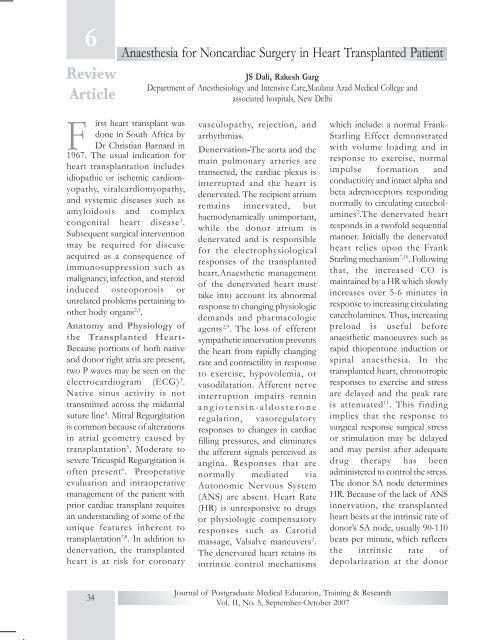National Board Ex- 6 Book .pmd - National Board Of Examination
National Board Ex- 6 Book .pmd - National Board Of Examination
National Board Ex- 6 Book .pmd - National Board Of Examination
You also want an ePaper? Increase the reach of your titles
YUMPU automatically turns print PDFs into web optimized ePapers that Google loves.
6ReviewArticleAnaesthesia for Noncardiac Surgery in Heart Transplanted PatientFirst heart transplant wasdone in South Africa byDr Christian Barnard in1967. The usual indication forheart transplantation includesidiopathic or ischemic cardiomyopathy,viralcardiomyopathy,and systemic diseases such asamyloidosis and complexcongenital heart disease 1 .Subsequent surgical interventionmay be required for diseaseacquired as a consequence ofimmunosuppression such asmalignancy, infection, and steroidinduced osteoporosis orunrelated problems pertaining toother body organs 2,3 .Anatomy and Physiology ofthe Transplanted Heart-Because portions of both nativeand donor right atria are present,two P waves may be seen on theelectrocardiogram (ECG) 3 .Native sinus activity is nottransmitted across the midatrialsuture line 4 . Mitral Regurgitationis common because of alterationsin atrial geometry caused bytransplantation 5 . Moderate tosevere Tricuspid Regurgitation isoften present 6 . Preoperativeevaluation and intraoperativemanagement of the patient withprior cardiac transplant requiresan understanding of some of theunique features inherent totransplantation 7,8 . In addition todenervation, the transplantedheart is at risk for coronaryJS Dali, Rakesh GargDepartment of Anesthesiology and Intensive Care,Maulana Azad Medical College andassociated hospitals, New Delhivasculopathy, rejection, andarrhythmias.Denervation-The aorta and themain pulmonary arteries aretransected, the cardiac plexus isinterrupted and the heart isdenervated. The recipient atriumremains innervated, buthaemodynamically unimportant,while the donor atrium isdenervated and is responsiblefor the electrophysiologicalresponses of the transplantedheart.Anaesthetic managementof the denervated heart musttake into account its abnormalresponse to changing physiologicdemands and pharmacologicagents 2,9 . The loss of efferentsympathetic innervation preventsthe heart from rapidly changingrate and contractility in responseto exercise, hypovolemia, orvasodilatation. Afferent nerveinterruption impairs renninangiotensin-aldosteroneregulation, vasoregulatoryresponses to changes in cardiacfilling pressures, and eliminatesthe afferent signals perceived asangina. Responses that arenormally mediated viaAutonomic Nervous System(ANS) are absent. Heart Rate(HR) is unresponsive to drugsor physiologic compensatoryresponses such as Carotidmassage, Valsalve maneuvers 2 .The denervated heart retains itsintrinsic control mechanismswhich include: a normal Frank-Starling Effect demonstratedwith volume loading and inresponse to exercise, normalimpulse formation andconductivity and intact alpha andbeta adrenoceptors respondingnormally to circulating catecholamines2 .The denervated heartresponds in a twofold sequentialmanner. Initially the denervatedheart relies upon the FrankStarling mechanism 7,10 . Followingthat, the increased CO ismaintained by a HR which slowlyincreases over 5-6 minutes inresponse to increasing circulatingcatecholamines. Thus, increasingpreload is useful beforeanaesthetic manoeuvres such asrapid thiopentone induction orspinal anaesthesia. In thetransplanted heart, chronotropicresponses to exercise and stressare delayed and the peak rateis attenuated 11 . This findingimplies that the response tosurgical response surgical stressor stimulation may be delayedand may persist after adequatedrug therapy has beenadministered to control the stress.The donor SA node determinesHR. Because of the lack of ANSinnervation, the transplantedheart beats at the intrinsic rate ofdonor’s SA node, usually 90-110beats per minute, which reflectsthe intrinsic rate ofdepolarization at the donor34Journal of Postgraduate Medical Education, Training & ResearchVol. II, No. 5, September-October 2007
















